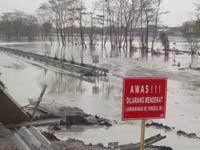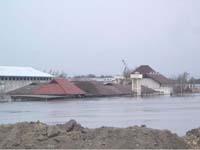Desire and impossibility to stop the eruption of mud

The eruption of the mud has not ceased since its inception. (Photo: R. R. Nijenhuis/UN)
On 28 May 2006, in the Sidoarjo district of Indonesia's Java Island, hydrogen sulphide was extracted from an open fissure in the soil. This gas is toxic and the concentration in the air of the area that day was harmful to people. However, the gas concentration decreased greatly for the next day and the third day there was no hydrogen sulfide in the air.
After the gas, however, fissures began to flow hot mud. The escape began to flow the day after the escape and since then it has not ceased. They still do not know why the mud eruption began. It was initially associated with an earthquake that took place on the eve of the gas spill. For many, it is possible that the company PT Lapindo Brantas derives from the gas search surveys it was carrying out.
However, since May 29 last year, it has emitted 40,000 cubic meters of hot mud per day. All efforts made to slow the flow and channel the mud have been sterile and the consequences are being hard: 24,000 people have had to leave their homes, on November 22 a gas pipeline exploded by the weight of the mud, which has meant the death of 13 workers, the death of two other workers who worked in the fight against the disaster since the beginning of the eruption...
Origin of the eruption
And no one knows how to stop it. Scientists are collecting data and analyzing the situation, but they don't know what to do. There are two thousand mud volcanoes around the world, some of them east of Java, but they do not know them well.
Compared to the rest, the game of Sidoares is special for its volume and for being very watery. The 70% of the mud is water, so it is not anything viscous backwards. Analyzing the fossils present in the mud, scientists have concluded that the particles present in the mud come from a layer of schist and argilite at a depth of 1220-1,830 meters. According to the calculations made, this layer presents alternatively sand beds that reach 3,000 meters of depth. Below is the limestone layer that PT Lapindo Brantas planned to drill for gas.

They do not know whether the eruption began by itself or by human influence. However, now the priority is to stop the flow. (Photo: R. R. Nijenhuis/UN)
Geologist Richard Davies and scientists who with him investigate the eruption believe that the water of the eruption of mud comes from the limestone layer.
In the first analysis they have published on the phenomenon of Sidoarjo, it is explained that the company PT Lapindo Brantas carried out a survey in a pond near it and that it seems that it was excavated. Consequently, water and high-pressure gas found an escape. With force, the rock was cracked and the hot water liquid its materials and pushed them outward. Scientists believe that this is how the eruption began and has not ceased since.
The company, for its part, relates the eruption with the earthquake that occurred on the eve. According to them, the waves of the earthquake caused the fissure and the next day they began to extract the gas and then the mud.
However, for scientists this hypothesis has no strength. The eruptions caused by the earthquake occur immediately after they have been shaken. However, in Sidou, the gas began to leave the day after the earthquake and spent another day when the mud began to flow. In addition, before this earthquake there have been others in the area, both closer and stronger, that have not caused such a catastrophe.
Chains to stop flow
They have not yet clarified, therefore, how the eruption began. But everyone is clear that something needs to be done. But what? The three geologists of the Bandung Institute of Technology have developed a plan to curb the flow that has already begun.
Through Sonarra they discover that the hole that flows the mud has a T-shape, that is, it suddenly narrows a lot. If this narrowing is managed, geologists have considered that the flow would be reduced considerably. Thus, they decide to put to the hole concrete balls of between 300 and 400 kilos joined by a chain. In this way, in addition to reducing the hole, the chains will hinder the mud and lose force by friction.
It is estimated that with a thousand chains the flow of mud will be reduced in three quarters. It is not a matter of totally stopping the eruption (which they do not expect), but of gaining time to continue investigating and, if not another thing, to end the work being done to channel the mud towards a river.
The first chains have already been released. Nothing has yet been noticed about the eruption, in fact no influence is expected until one hundred chains have been thrown. However, they may not reach their goal. As many times, the problem is money, or rather, the lack of money: at the moment they only have 374 chains and do not know if they will have money to do more.
There are many questions to answer. Meanwhile, the mud continues to emerge. It will soon stop, but the most pessimistic believe that there is danger that the mud extraction zone will fall, since erosion has created caves below. Its inhabitants have no intention of betting.
Published in Gara.
Buletina
Bidali zure helbide elektronikoa eta jaso asteroko buletina zure sarrera-ontzian











